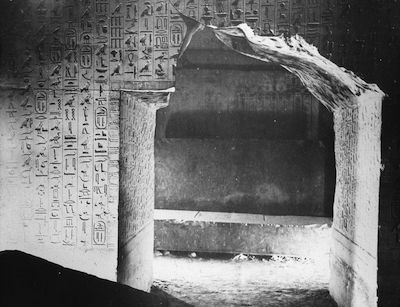Ancient Egyptian literature takes a variety of forms and was written in hieratic, demotic, and hieroglyphic text for different occasions and purposes.
Stelae were inscribed with hieroglyphs and generally used for proclamations and for recording successes (or re-casting a defeat as a success). Similarly, the hieroglyphic inscriptions on the walls of their temples were a useful propaganda tool of the pharaoh and the priests. As a result, they tend to give the most positive view of the current pharaoh or make implications regarding the perceived quality of a previous pharaoh which may have been prompted more by political motivations than a desire to record the “truth”.

Inscriptions in tombs (also in hieroglyphs) are similarly careful to paint a positive picture, but are likely to include some of the events of the deceased’s life and so can provide useful facts about the period, as well as illustrating the prevailing religious environment.
Many of the Ancient Egyptian myths are incomplete, while others have numerous versions in different locations or times. This makes their already complex mythology very confusing in places, with the characters and attributes of gods reinforced or contradicted by other texts.
The scribe was an essential part of ancient Egyptian life, copying texts and preparing new documents to perpetuate and expand the Egyptian culture as well as performing the more mundane tasks of tax collection, architecture, and recording legal rules and verdicts.
Stelae
Rosetta Stone – The Rosetta Stone gave Egyptologists an invaluable key to begin to decipher hieroglyphs.
Palermo Stone – The Palermo Stone gave Egyptologists lists the kings of the early dynasties along with details of their reigns.
The Dream Stele (Sphinx Stele) – The Sphinx promises Tuthmosis IV he will be king if he clears the sand that has engulfed it away.
The Stele of the Rameside Family – Established in Tanis during the reign of Ramesses II.
The Israel Stele (Victory Stele) – Established during the reign of Merenptah, the stele recounts his battle against the Libyans and the Sea People and contains the first known reference to Israel.
Records and Correspondence
Papyrus Anastasi V – The report of two runaway slaves during the time of Seti II who may have followed the route the fleeing Israelites allegedly used when escaping Egypt.
The Armarna Letters – Correpondence between the pharaohs Amenhotep III and Akhenaten to the rulers and vassals of the Middle East.
Letter to Suppiluliuma – An Egyptian Queen (possibly Ankhesenamun/Ankhesenpaaten the wife of Tutankhamun) wrote to Suppiluliuma I of the Hittites requesting that he send one of his sons for her to marry.
Biographies
Biography of Ahmose son of Ebana – Ahmose was a career soldier who served the pharaohs Seqenenre Tao II, Kamose, Ahmose I and Tuthmosis I.
Literature and Poetry
Story of Sinuhe – The Story of Sinuhe (Sanakht) was possibly the first historical novel.
Princess of Bekheten – The story of how Khonsu healed a foreign princess.
Westcar Papyrus – Tales of Wonder from the Court of King Khufu including: Story of Imhotep, Story of the wax crocodile, Story of the turquoise pendant, Story of Khufu and the magician and Story of the birth of the three pharaohs.
Song of the Harper – Poems inscribed on the walls of tombs that were sung during the mortuary feast.
The Instructions of Dua-Khety (The Satire of the Trades) – The Instructions of Dua-Khety (The Satire of the Trades) satirises other occupations and concludes that the life of a scribe is the best.
Religious Texts

Pyramid Texts
The Pyramid Texts are oldest religious texts in the world, inscribed in pyramids from the fifth dynasty.
Coffin Texts
The Coffin Texts are a huge corpus of spells which were painted on coffins during the Middle Kingdom. They were not painted on all coffins, and some spells were specific to a particular area or time, but they form a fascinating link between the Pyramid Texts and the Book of the Dead.
Book of Two Ways – The Book of Two Ways is a collection of Coffin Texts from the Middle Kingdom which constitutes the earliest attempt to create a map of the netherworld, along with a description of the guardians and demons who inhabit it.
Spell of the Twelve Caves
The Spell of the Twelve Caves is a New Kingdom text which describes the Netherworld as a series of caves, each filled with a variety of generally friendly deities.
Book of Gates
The Book of Gates charts the journey of the ancient Egyptian sun god, Ra, through the underworld at night (New Kingdom).
Artefacts

Copyright J Hill 2010